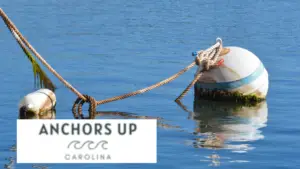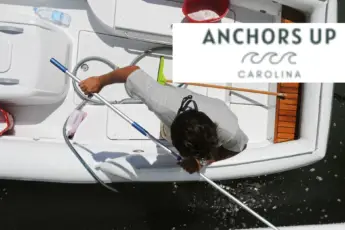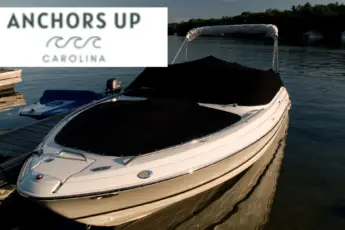One of the most simple ways to hold the position of boat in open water aside from anchoring is using a mooring ball. The floating ball is highly visible at the surface of the water and is fitted with a pennant. Interestingly, the moorings are placed and maintained by cities, parks, towns, and marines and are most often found in large clusters. I have used moorings a significant number of times and find them to be far easier compared to dropping anchor. Learn what exactly a mooring ball is and how to use one.
How Are Mooring Balls Affixed To The Seafloor
Without question, the mooring must be securely placed in order to prevent the vessel from drifting off. For this reason, cement is poured on the seafloor as this provides enough weight to avoid the mooring from dragging.
The cement block is fitted with a shackle when the concrete is poured. Shackles are held firmly in place as the concrete hardens again to avoid mishaps of a boat going adrift. The shackle is the first point of connection between the concrete block and the vessel floating above.
What Are The Components Of A Mooring Ball
A mooring is relatively straight forward but likely has more components than you would expect. As noted previously, a shackle is cemented into the concrete base as this is the first point of connection between the seafloor and the pennant at the surface.
The bottom shackle connects directly to one of two different chains leading to the surface. First is the bottom chain, which is typically far more stout compared to the upper portion of the chain. Secondly is the upper chain. The upper chain is smaller in diameter and is linked by a shackle between the lower and top sections.
Next, above the surface of the water, is the mooring ball. Moorings are most often white in color, as this makes them highly visible. Importantly, the upper chain passes through the center of the ball. After passing through, an additional shackle is connected at the end of the chain.
Lastly, a pennant connects to the shackle on the top of the ball. The pennant is a length of line with a loop on the end. For this reason, the boater is able to pass a line through the eye and back to the cleat on the boat.
Can You Rely On Moorings
Unfortunately, you cannot get a 100 percent guarantee that all moorings will hold the boat in position as intended.
With that being said, I have used moorings consistently throughout the United States Virgin Islands and British Virgin Islands without an issue.
For the most part, an agency is in place to inspect moorings on an annual basis. However, the components are prone to wearing out.
To better understand, first consider the environment, especially in saltwater. Saltwaters’ corrosive nature deteriorates metal chains. Secondly, some parts of the chains or lines are dragging on the bottom. The constant dragging along the sand or rocky bottoms erodes the metal or line, causing it to break. Lastly, the bottom chain connects to the top chain via a shackle. Again, the constant dragging from the natural motion of the water causes the shackle to thin and break.
Fortunately, the vast majority of mooring balls are inspected, and failing components are replaced before they become an issue. However, you should always be on alert when securing to a mooring.
How Do You Approach And Secure To A Mooring
Without question, you will want to gain approval to utilize a mooring if it is regulated by an agency. In some situations, you are required to pay a fee. The fee is in place to allow for continued maintenance of the moorings.
I highly suggest having at least two people on board when approaching a mooring. Undoubtedly it will make the task of becoming secured far easier. One person operates the vessel while the other person grabs the pennant loop and secures the vessel to the mooring.
Have The Required Gear In Hand
Trust me; you will want to have the necessary gear in hand when approaching a mooring. The items include a boat pole and dock line. Importantly, you will want to have the dock line secured to the bow cleat. Never connect a boat to a mooring from the stern cleats.
The Approach
It should be noted that it is not a race to get secured to a mooring ball. Trust me, if you rush the approach, you’re either going to miss entirely or run it over.
To approach, make your best effort to keep the bow directly into the wind as you will maximize your ability to control the boat.
Bump the vessel in and out of gear so that you are positioned with the ball on the port or starboard side of the bow.
Hook The Loop Of The Pennant
This step is where the boat pole comes in handy. Rather than bending over the boat to grab the pennant by hand, use the book hook to pick up the loop.
Once the loop is hooked, lift the pole upwards with the hook remaining at the lowest point. Retrieving the pennant by using this method prevents the pennant’s eye from falling off. Lastly, grab the loop and hold it with your hand.
Run The Line Through The Pennant Loop And Connect To A Cleat
Remember, the bow line is already connected to one of the two bow cleats. Run the line through the eye of the pennant. Once the eye passes through the center of the loop, connect the bitter end to the opposite bow cleat. The double point connection allows the boat to position more naturally as compared to constantly being pulled from one side in wind and current.
Take Advantage Of Mooring Balls
Whenever a mooring ball is available, I recommend utilizing the ball compared to an anchor. Anchors damage seafloors and especially coral reefs. Approaching and securing to a mooring requires practice. Don’t become discouraged if you miss on a few of your attempts. When possible, I prefer to use moorings, especially if I am snorkeling over shallow reefs.







